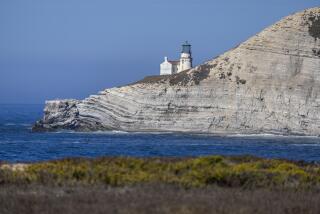Florida’s Wild Swamp
- Share via
CORKSCREW SWAMP, Fla. — In the midst of these 11,000 wild acres, nature’s sounds capture your ears:
Wind sweeping across the great central marshlands; the call of a red-shouldered hawk; the splash of a nut as it shatters calm, tea-colored waters after a squirrel drops it from a tall cypress tree; a pair of wild river otters noisily chewing their way through a bed of duckweed; the peep of thumb-size Carolina wrens scurrying through the underbrush; the great phlomp, phlomp of a wood stork’s wings as it steers its way through the trees.
This great sanctuary of the Audubon Society in southwest Florida is a wonderland for naturalists, a place where more than 100 species of birds have been counted. It’s where alligators sun on rotting logs only a few feet from your camera lens and giant pileated woodpeckers flash their saucy red crests as they attack tree trunks looking for a meal of carpenter ants or grubs.
In Corkscrew, one is likely to see raccoons searching the water for crayfish, trees in which white ibis cover the branches like a new snowfall and broad expanses of prairie where wildflowers seduce the eye with their Crayola colors.
Corkscrew Swamp is what much of Florida was before the railroad came and brought the developers, before the Everglades were drained and raped, before Disney and Miami Beach, reptile farms and tourism.
Virgin bald cypress trees, some of them 700 years old, soar 130 feet high in Corkscrew Swamp, as they did two centuries before Columbus crossed the ocean and the Spanish gained a foothold in Florida.
Wild Side of Florida
For the traveler who wants to see the wild side of Florida, there is no better place than Corkscrew. Unlike the Everglades, there are no air boat rides through this wilderness, no giant-tire vehicles to crush the grasses and sully the landscape. Corkscrew is a natural experience, a walk into a Florida of a thousand years ago.
Visitors to Corkscrew Swamp enter through a small reception building where Audubon personnel will ask for $4 ($2 for high school and college students; children under 6 are free), then give you an illustrated brochure to help you understand the ecology and wildlife of the swamp.
Then it is off on a mile-long stroll on a boardwalk, elevated just a few feet above the swamp to protect the delicacy of the place.
At first the walk is relatively dull and free of wildlife as one meanders through a low pine forest and across a wet prairie. But soon one will be in the midst of the sanctuary and will begin to see a variety of birds--the red flash of a cardinal, the gray shadow of a tufted titmouse, the stately magnificence of a great egret as it waits for a fish (or a baby alligator) to come its way for lunch.
Fish and Fowl
On the deck overlooking the central marsh, about halfway through the journey, one can pause to hear the call of hawks, to watch turkey vultures ride the wind, to smile as a fat brown wasp plays hide-and-seek, to relax in the warming sun of a Florida afternoon.
As you walk the weathered boardwalk, numbered plaques correspond to paragraphs in the booklet provided by the Audubon folks. At No. 10, for example, it says to look in the water for mosquito fish and, sure enough, there the tiny creatures are, the happy reason mosquitoes are fairly rare in the swamp. At No. 54 the booklet says to be on the lookout for alligators in the lettuce lake; I saw a dozen.
Everyone has his own special moments along the walk, which should be made slowly and with as little noise as possible. Discovering a pair of sleek river otters was my highlight; a tourist from Wisconsin told of seeing a family of raccoons playing in the water; a birder from Pennsylvania was thrilled at seeing his first wood stork.
Everyone will leave with memories after visiting Corkscrew Swamp, where life in this great wilderness is much as it was a millennium ago. Considering Florida’s abundance of high-rise condominiums and luxury hotels, traffic jams and air pollution, that is reason enough to spend a day in Corkscrew Swamp.
Corkscrew Swamp is about 40 miles southeast of Fort Myers, 25 miles northeast of Naples. It can be reached off Interstate 75 by taking Florida 846.
Corkscrew Swamp is open daily from 9 a.m. to 5 p.m. No picnicking or overnight camping is permitted (a picnic area is just outside the boundary). No pets are allowed.
For more information, write to Corkscrew Swamp Sanctuary, Route 6, Box 1875, Sanctuary Road, Naples, Fla. 33964 or contact your local chapter of the National Audubon Society.
More to Read
Sign up for The Wild
We’ll help you find the best places to hike, bike and run, as well as the perfect silent spots for meditation and yoga.
You may occasionally receive promotional content from the Los Angeles Times.




